Meldrum Rethinks the Shipton & Cronin Yeti Tracks
Posted by: Loren Coleman on April 16th, 2012
Meldrum Rethinks the Shipton & Cronin Yeti Tracks
© Loren Coleman 2012
“Ideas, like large rivers, never have just one source.” ~ Willy Ley
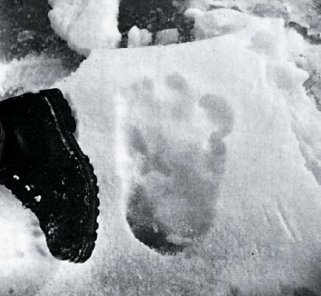
In Willy Ley’s chapter entitled “Abominable Snowman,” in his book Salamanders & Other Wonders (1955), the mid-century German-American romantic and exotic zoology commentator wrote of the 1951 expedition to Mt. Everest. Ley said of the remarkable find of Yeti footprints: “Eric Shipton, who had come across the tracks when they were still fresh, took a photograph which proves that, no matter how many ‘Yeti tracks’ were really made by bears, these were decidedly not. There is no mammal known to science in this area which leaves such tracks. And although they resemble human tracks they are as decidedly ‘unhuman.'”

The reality of the footprint finds caused a rush of reviews, reconstructions, and reactions, from casts of the print to stamps being printed.
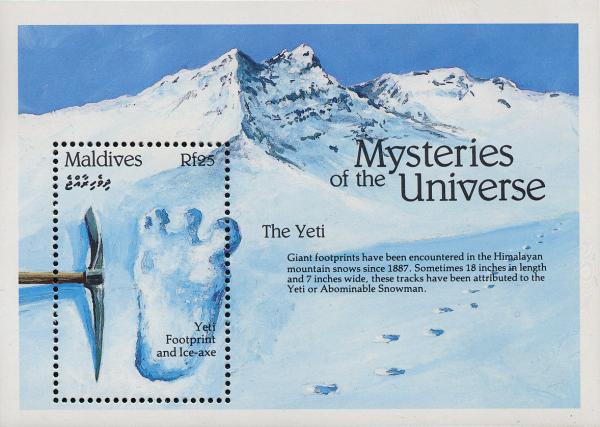
In recent days, I have discussed the circumstances behind the photographing of the 1951 Eric Shipton-Michael Ward-Sen Tensing discovered Abominable Snowmen or Yeti footprints. In “A Short History of the Shipton Snowman Track Photographs and the Tchernezky Cast,” the role of zoological technician Wladimir Tschernezky, the first creator of a replica Shipton track cast, was detailed. Furthermore, in that examination and in “Shipton Yeti Created Cast,” the post-reconstruction errors were investigated.
In this present essay, I will overview how D. Jeffrey Meldrum, Ph. D., an Associate Professor of Anatomy and Anthropology and Adjunct Associate Professor of the Department of Anthropology, Idaho State University, has revisited and newly reconstructed the Shipton tracks, as well as the more recent Cronin footprints.

After the Shipton photographs were published in 1951, one of the first attempts to debunk them occurred at the British Museum in December 1951. The major thrust of the exhibit was to present known animals and their footprints to explain the newly found “Yeti tracks.”
One of the favorite candidates of the British Natural History Museum’s effort was what was called, at the time, the Himalayan langur (Presbytis entellus).
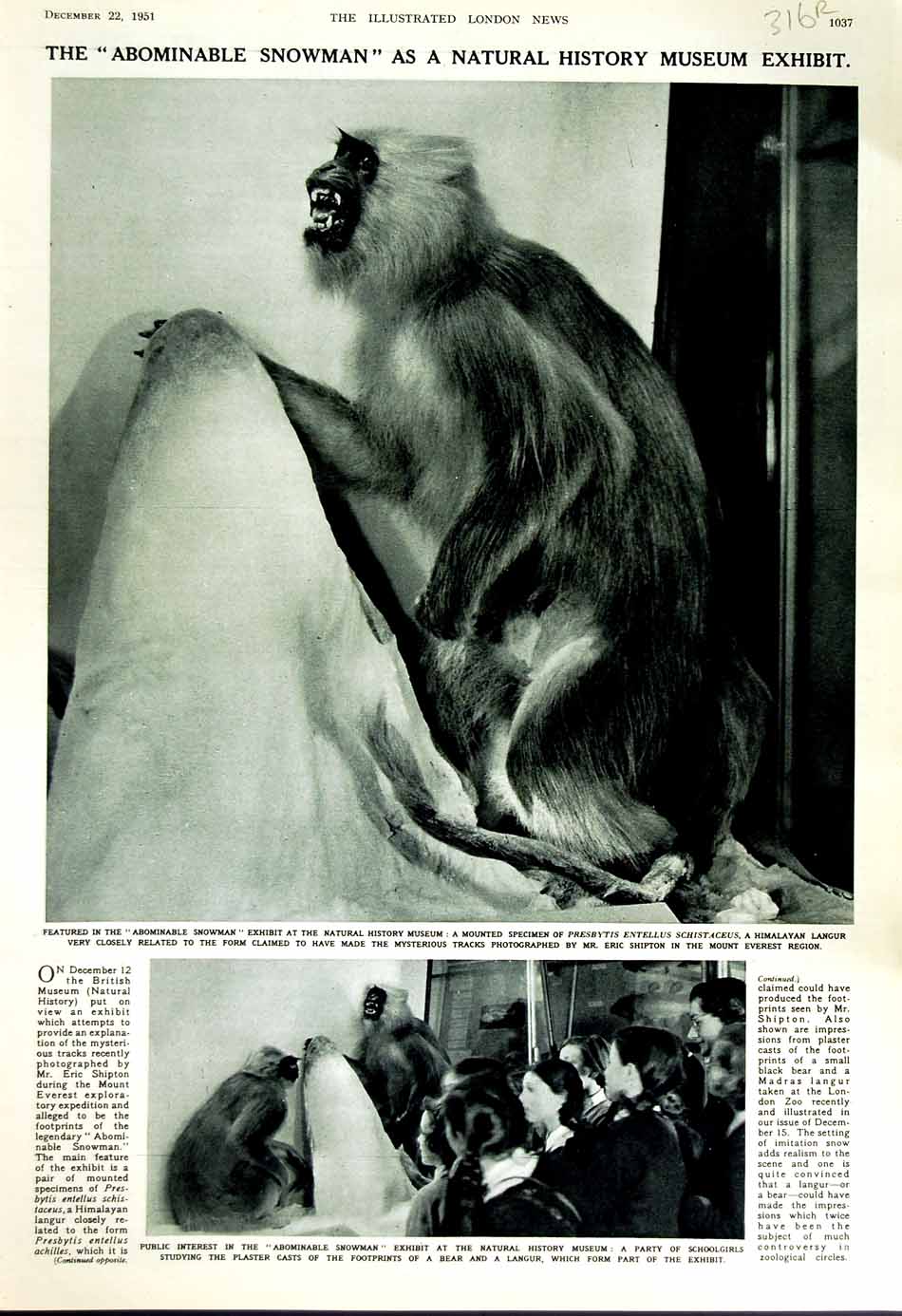
But the footprint of the langur does not match the Shipton track.

The bulk of the Shipton 1951 print dwarfed a langur track.
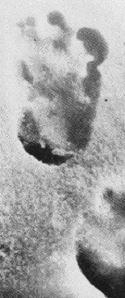
The massive nature of this 1951 footprint especially came forth after the reconstruction of the track from Wladimir Tschernezky’s cast replica (below).

The Shipton track cast was also then reproduced in various forms since 1960.

Grover Krantz shared, in his Bigfoot Sasquatch Evidence (Surry, BC: Hancock House, 1999: 207, Figure 79), the above image with this caption: “Replica of Shipton footprint. A Nepalese craftsman made this image of what the foot should have looked like that made the famous footprint that Shipton photographed in 1951. The original was given to the Brooklyn Children’s Museum, where this copy was made through the courtesy of Michael Cohn.”
The following cast in Loren Coleman’s personal collection (now at the International Cryptozoology Museum) shows the legacy it owes to the Tschernezky-Cohn designs of the Shipton casting.
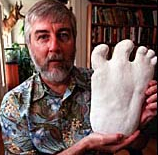
Needless to say, next sketches resulted, such as Ivan T. Sanderson’s drawing identified as “(9) ABSM (Meh-Teh). From photo of cast made from photo of print in snow, by Eric Shipton,” (below). The sketch demonstrates what Tschernezky said he did, via a different kind of cast copy that Sanderson owned, in which the Tschernezky-reconstructed left foot (with hallux on the left) was pressed into snow, cement, or plaster to create a mirror of the footprint (with a hallux image on the right).
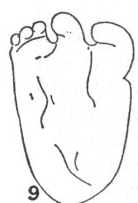
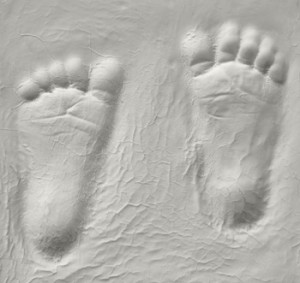
Amazingly, even in these discussions of the primary Shipton print, few have figured out that what we are looking at is the imprint of a left foot. Above are the tracks of a human infant, with the left footprint on the left, and the right footprint on the right. But if you fill these depressions, and cast these two tracks in plaster, they flip over and people are confused.
So we arrive at Jeff Meldrum’s interesting new reconstructions of the Shipton cast – on the right – (and the Cronin cast – on the left):
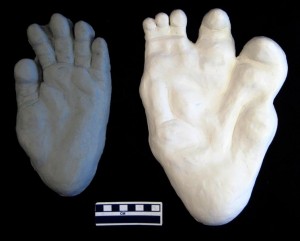
Meldrum’s cast on the left is his newly imagined configuration, from the 1951 Shipton track.

Meldrum sees the Shipton track heel as narrowing and the area around it having been caused by melting. John Napier, Jeff Meldrum, yours truly, Loren Coleman, and others have discussed, in lectures and print for years, that the heel of the Shipton/Ward individual print appears to be distorted by melting. Melting in snow can occur due to the sun, from elevated temperatures, from evaporation, and then be enhanced by wind direction. Therefore, the fact that enlargement would be most visible in the heel is not abnormal.
Meldrum’s caption about his casts, explains: “I did my own reconstruction of the print based on a slightly different interpretation of the relation of the footprint to the pattern of melted ice, giving the foot a more pongid appearance with a tapered heel and divergent great toe (on the right). The enlarged second digit is likely explained as a pathology, i.e. macrodactyly. The other cast is my attempt at reconstructing the foot responsible for the tracks discovered in the Arun Valley by the McNeeley-Cronin expedition.” April 4, 2012.
Meldrum’s cast appears to have been made of a right foot so the human eye can “see” it as the viewer first sees the Shipton imprint in the snow in 1951.
But below I have flipped the cast photograph to actually match the bottom of the foot that would have made the left foot print. As you can see, the appearance is difficult for the human brain to comprehend, upon first viewing it. How can any primate have a foot like this, the brain seems to ask itself? Our eye is so familiar with the “Shipton track,” the Meldrum Shipton reconstruction looks like it is from an alien. But look at it for awhile. You’ll get use to it.
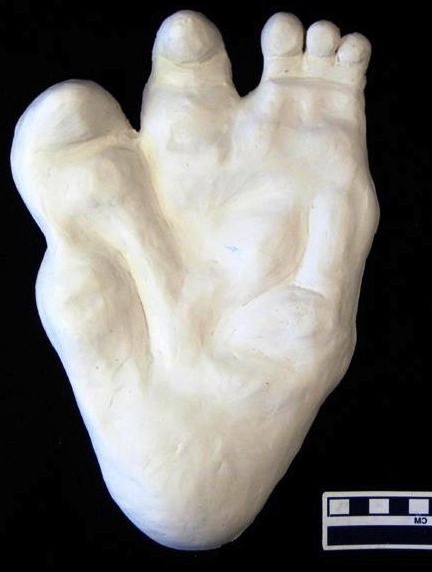
Significantly, in conjunction with the Cronin Yeti tracks, the Meldrum-Shipton footcast starts to make sense.
+++++++++++++++++++++++++++++++++++++++++++++++++++++++++++++++++++++++++++

“A mind once stretched by a new idea never regains its original dimensions.” ~ Oliver Wendell Holmes
+++++++++++++++++++++++++++++++++++++++++++++++++++++++++++++++++++++++++++
What are the “Cronin Yeti tracks”?
On December 14, 1972, a four man expedition left their base camp and started on a trek up the Kongmaa La Mountain, Arun Valley, northeast Nepal. The members of the group were two Americans, zoologist Edward W. Cronin, Jr. and physician Dr. Howard Emery and their two Sherpa guides. Cronin wrote of his finds in “The Yeti,” in Atlantic Monthly (November 1975); his book The Arun: A Natural History of the World’s Deepest Valley (Boston: Houghton Mifflin Company, 1979), and in reprints and remarks in various publications. Cronin, along with his good friends Jeffrey McNeely and Howard N. Emery, wrote of their discoveries in “The Yeti – Not a Snowman,” in Oryx (1973, 12: 65-73).
After easy going, when the Cronin party reached an altitude of about 10,000 feet, the group ran into a storm that made movement and visibility nearly impossible. The guides found a campsite in a valley at about 12,000 feet. Then the weather broke on December 17, and they pitched their tents and fell asleep. Overnight, some thing visited their camp. Emery was the first up the next morning, and immediately saw footprints. He let out a shout. The footprints were nine inches long and almost five inches wide.
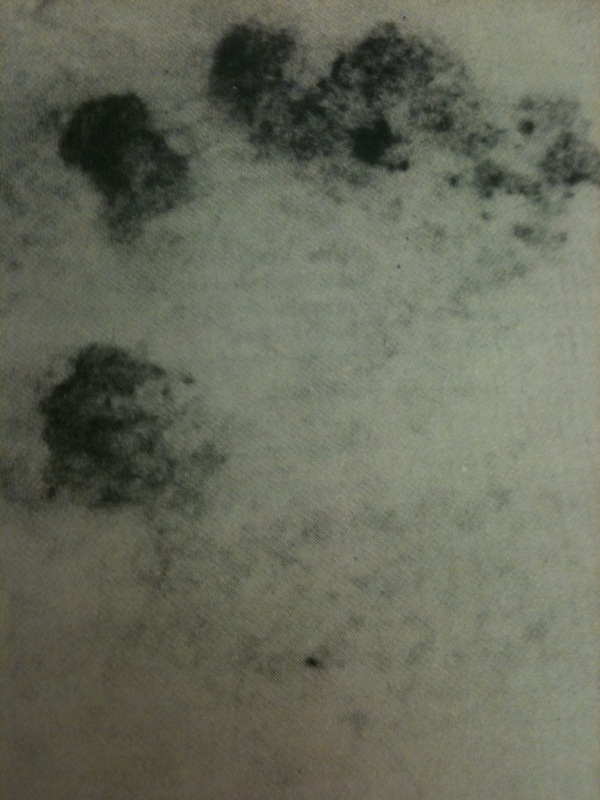
Photo of the track of an apparent right foot of a “Yeti” taken by Edward Cronin.

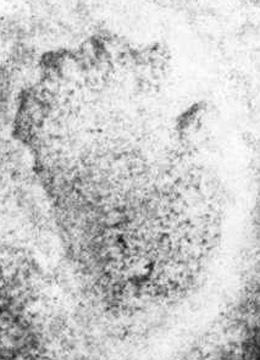
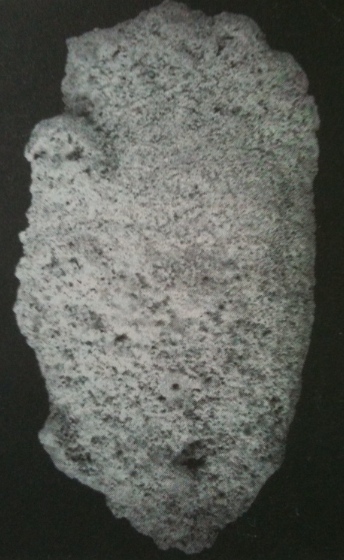
Various prints of a photo of one of the left foot tracks of a “Yeti” taken by Edward Cronin. Photo of left foot cast (as shown, casting does not retain good details from snow).
Emery and Cronin took photographs and later made plaster casts of the tracks. Then they followed the prints until they lost the trail in the bare rocks. Cronin was sure that the footprints had not been made by “any known, normal mammal.” The Sherpas had no doubts that it was a Yeti.
Cronin matched his own tracks left on the night of December 17 with those he made the next morning. Cronin considered all the prints near the camp had remained unaltered by the sun, wind or any of the elements.
The tracks appeared to be barefoot imprints left by a biped creature at night between their tents. The tracks were of 9 inches (23 cm) long and 4.75 inches (12 cm) wide.
The prints displayed precise details. It is visible on the photo that the foot of the hominoid has short and thick big toe put aside to the sole. The other four quite short toes are located widely at front part of foot. The back part of the foot is a wide rounded heel.
Members of the expedition had followed the tracks and found out that the creature approached the camp from the northern slope. From the camp the tracks continued onto the southern slope. Farther the hominoid came back onto the top of the ridge, crossing back and forth several times. Then the creature went down to the south slope where the tracks were ultimately lost in the bare rock and scrub. Cronin noted: “The creature must have been exceptionally strong to ascend this slope in these conditions. No human could have made overnight the length of tracks I could see from the top of the ridge.”
Comparing the images of hominoid tracks by Shipton and by Cronin shows the hallux separate from the middle of the foot on Cronin track is vaguely similar to Shipton’s, but there is no evidence of a larger than normal second digit on the Cronin track.
Zoologist Edward Cronin wrote articles or took extracts from his book, about his finds. These often would contained drawings of Yeti feet or tracks, which showed a left foot from the bottom and a right foot. These appeared in various publications, including Defenders of Wildlife and Atlantic Monthly; Pursuit reprinted the Defenders of Wildlife piece.

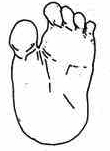
In slide presentations, Jeff Meldum, author of Sasquatch: Legend Meets Science, has shown his comparison of the Cronin track cast of a left foot with that of the left foot of a gorilla.


Looking specifically at Jeff Meldrum’s reconstruction of the left foot of the Cronin track (on the left here), it clearly appears similar to the foot of a great ape (pongid).
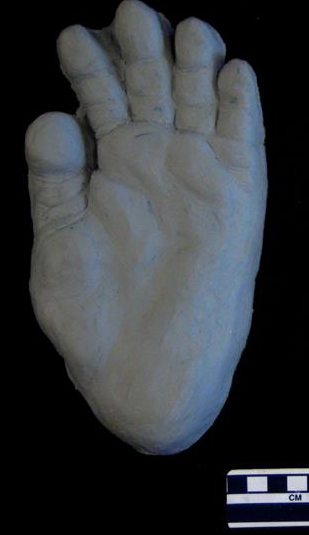
Flipping Meldrum’s image, to “see” it as a right foot, you can visualize how the bottoms of the left and right foot of a Yeti would appear.

Meldrum’s radical new view of the Shipton track, combined with a more pongid view of the Cronin tracks than ever before, gives forth with new ideas to ponder.
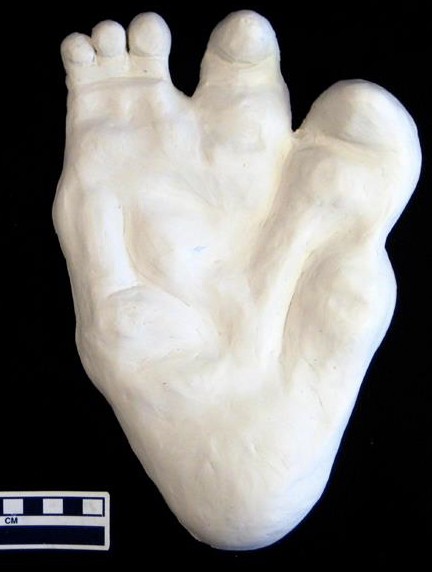
The iconic image of the Shipton track photograph, which has become the “type specimen” for what a Yeti footprint would look like, is based on more melting that most have wished to consider.


The Shipton track may be an enlarged pongid-like footprint, which is also shown in the Cronin imprints.
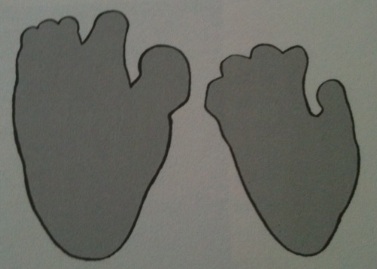
The outlines (above) of the Shipton footprint and the Cronin print, published by Jeff Meldrum in his book, Sasquatch: Legend Meets Science (p. 41), demonstrates there is more to be found in common, than different, in comparing these probable Nepalese primate’s track finds.

Rarely do artists get the feet right on their Yeti sketches, but you will note that Wladimir Tschernezky certainly tried to technically get them correct. We can only hope, based upon Jeff Meldrum’s thoughtful reconstruction of what Yeti feet may look like, the physical representations will improve in the future.

“There is precious little in civilization to appeal to a Yeti.” ~ Sir Edmund Hillary.
About Loren Coleman
Loren Coleman is one of the world’s leading cryptozoologists, some say “the” leading living cryptozoologist. Certainly, he is acknowledged as the current living American researcher and writer who has most popularized cryptozoology in the late 20th and early 21st centuries.
Starting his fieldwork and investigations in 1960, after traveling and trekking extensively in pursuit of cryptozoological mysteries, Coleman began writing to share his experiences in 1969. An honorary member of Ivan T. Sanderson’s Society for the Investigation of the Unexplained in the 1970s, Coleman has been bestowed with similar honorary memberships of the North Idaho College Cryptozoology Club in 1983, and in subsequent years, that of the British Columbia Scientific Cryptozoology Club, CryptoSafari International, and other international organizations. He was also a Life Member and Benefactor of the International Society of Cryptozoology (now-defunct).
Loren Coleman’s daily blog, as a member of the Cryptomundo Team, served as an ongoing avenue of communication for the ever-growing body of cryptozoo news from 2005 through 2013. He returned as an infrequent contributor beginning Halloween week of 2015.
Coleman is the founder in 2003, and current director of the International Cryptozoology Museum in Portland, Maine.










So, the Shipton tracks were made by a Yeti suffering from malformations, according to Meldrum’s new interpretation. Did I get it right?
It’s interesting to note that, unlike the American Sasquatch, the Himalayan Yeti is not so quickly scoffed at by scientists. Some famous ones, such as George Schaller and David Attenborough (spelled right?) have expressed serious interest in its existence. With Meldrum’s work on the above tracks, perhaps more will be intrigued.
Having said that, it’s going to take several, if not many non-stop expeditions to the region, long term expeditions, with weaponry (bullets or Tranquilizer darts, or both) and the best tech and equipment available to snag one. Perhaps a satellite that is focused on the expedition’s rough location (i.e. on a area within a radius of a mile from the team?) could be used in the hunt. But like the hunt for Sasquatch, this has to end, before these animals are gone forever.
Hapa writes;
“It’s interesting to note that, unlike the American Sasquatch, the Himalayan Yeti is not so quickly scoffed at by scientists.””
I also find it interesting, and quite frankly bizarre considering that the Yeti doesn’t have a fraction of the evidence and persuasive consistency that sasquatch has going for it.
It has all to do with the locale. Nepal sounds much more remote and rugged than British Columbia……even though the reverse is actually true.
I have an open mind regarding the Yeti but the famous Shipton track is such a one off that my opinion is the same as Grover Krantz, and I will quote him………”Until another photograph or cast of that particular foot design turns up, I see no point in taking it seriously.”
Grover Krantz did write: “Until another photograph or cast of that particular foot design turns up, I see no point in taking it seriously.”
Grover Krantz took a narrow view of hominology worldwide. He felt there was only one new species of hairy bipedal hominoid to be discovered, and any reports from around the globe had to all be of the same thing. He and I discussed this topic often, and you know where I came out on that “one species” view.
With regard to the Yeti, Krantz was also guilty of what he accused other scientists of doing to “his” Sasquatch. He felt that Sasquatch evidence was routinely ignored, overlooked, and unread about Bigfoot, but, in general, that’s exactly what he did with Yeti material.
The quote from Krantz above, on the Shipton Yeti track, placed in context, is very revealing. Krantz devoted one paragraph to the Yeti/Abominable Snowmen, and only refers to having read one major source on the Shipton tracks: Ivan T. Sanderson.
Krantz, without much study, therefore, dismisses, ignores, or may have been unaware of decades of serious scientific research on the Yeti, as expressed in the sentence quoted above. If you read Krantz’s other sarcastic sentence right before it, you will see more deeply into Krantz’s foundation thinking: “Ivan Sanderson made much of this photo, along with native reports, to build a picture of some kind of ape that was only partially bipedal.”
The other photographs of good tracks and casts did turn up, i.e. the Cronin-Emery evidence from 1972. Krantz seems to have ignored how they fit into the overall Yeti picture with the Shipton photos.
I applaud Jeff Meldrum for pushing the envelope even more than Krantz. And not being afraid of what he might find.
Kopite:
Hello 🙂
“It had all to do with the locale. Nepal sounds much more remote and Rugged than British Columbia…even though the reverse is actually true.”
That’s hard for me to swallow, due to the higher altitudes and several authors writing about its remoteness. Then again I don’t know the population numbers of Nepal compared to BC, nor the road system used in both (I would think the road system of BC is better and larger than Nepal). I’ll do some checking about the population of the two combined (Canada as a whole has I think 30 million people in it: with such a vast nation, and with much of the population living nea the American/Canadian Border, You could be on to something.).
I Think that both animals are true, but we have to remember that there are 3 types of Yeti out there, and are not necessarily related to each other: The Meteh, The Tel-hma, and the Dzu-teh, the latter the largest type of Yeti, and one proven recently (with perhaps a few sighting exceptions, which look more like North America’s Sasquatch, even bigger than the traditional Cone-headed Yeti) to be Himalayan Brown Bears (i.e. the Himalayan Red Bear, Ursus arctos isabellinus and the Himalayan Blue Bear/Tibetan Bear/Tibetan Blue Bear, Himalayan Snow Bear/Horse Bear, Ursus arctos Pruinosus).
I’ll be back with Nepal/BC Population Stats.
Here we go;
http://en.wikipedia.org/wiki/Nepal
http://en.wikipedia.org/wiki/British_Columbia
Here are the stats about land/population/density written down:
Nepal:
Population 26,620,809
Population Density: 518.1/sq.miles
Total area: 56,827 sq. miles (2.8% of that is water)
British Columbia:
Population: 4,400,057
Population Density:12.3 sq. miles
Land area (not counting water): 357,216 sq. miles
Doesn’t sound right on the Population density, does it? The smaller population and larger land area of BC should make for a far less density of Population than Nepal, with a population approaching Canada’s as a whole and a far smaller country to put those people in. Possibly this is due to perhaps a larger concentration of Nepal’s population in cities instead of rural and wild regions as opposed to British Columbia, with a population spread out more, and more roads. Nevertheless you’re correct about the smaller population overall and the larger territory of BC.
Schaller considers the evidence for yeti and sasquatch pretty much equally persuasive, as does Goodall.
Too much emphasis is put on remoteness. For something like this to be unconfirmed, all that is required is for no one to take anyone who sees one seriously. People who haven’t thought about this don’t understand what a critical factor that is. 99.999999% of wildlife sighters come out of the woods with no evidence but what their eyes showed them. If no one believes you, who cares how many there are?
Reading Bindernagel’s books will give you a good idea why scientists, and most laymen who haven’t seen one, don’t even take the evidence seriously enough to look at it ….and why it’s long past time they should. He’s looked at this a lot; and he thinks that it’s at least as logical to find these animals in Ohio, PA and Maryland as it is to find them in the PNW. Better habitat, for one thing.
Right. Back to the yeti.
I have always felt, even with the similarity to gorillla tracks, that there was something funny about the Shipton print. (And yes, too funny to be a known animal.)
This is really interesting, and there may be something to it. With the number of trackways that have been found, for both yeti and sasquatch, why wouldn’t we, sooner or later, find one with a deformity? No logical reason. And we have for sasquatch too. Until somebody comes up with a better explanation, I’m down for this one.
DWA:
One reason people put emphasis into remoteness is that with fewer people around, the likelyhood of a species going undiscovered (especially megafauna) skyrockets. Plus with more people around in less remote regions, especially in the Western world, this means more roads equaling more cars and other vehicles, which means more animals get hit by a car. Though Asian Black Bears are known to be wary of roads, animals In the US, from Brown Bear to squirrel to deer to Boar and so on, get hit with vehicles all the time. Sasquatch, being most likely nocturnal to semi-nocturnal (the Patterson film, many (though not necessarily most) sightings, have been in daytime) can avoid being hit by cars and other vehicles better than daytime animals due to fewer people on roads, but when considering that 300+ million people live in the Lower 48 (with growing population, means more people in woods with guns, More hikers, more boyscout excursions, more photographers and wildlife biologists and Leftist nature lovers roaming about, More logging, more habitat enroachment, and like Bears and Moose do, more probability of a Sasquatch being sighted and even clearly filmed exploring neighborhoods for food), and that the road system has become ginormous across the Lower 48, Meaning that there is ample opporitunity for the beast to cross the road and get hit by a vehicle and proven in that fashion, makes it hard for most people, let alone most scienists, to think that such a Megafauna animal could hide in so crowded, so ill-remote, so heavily trafficked region without being shot captured or better photographed/filmed than they have been. This is one reason (among many) why Sasquatch sightings in regions like Illinois and Pennsylvania are thought of by some to be more paranormal, and are called “Hairy Bipeds” (Coleman and Jerome Clark wrote about this in a big fat book about the unexplained. I’ll write down the exact title and page numbers shortly).
However, just because it is improbable does not mean it is impossible. If the Ketchum DNA results include specimens from Kentucky and other regions of the south, as well as up north in Ohio and Pennsylvania, and further inquiry finds no shennanigans going on, well it is proven at least to the open minded that something is “A-FOOT” in unremote regions of the US at least.
One place in the Northeast which could prove to be actual Sasquatch habitat: the Pine Barrens of New Jersey, which not only house the legendary Jersey Devil (some Sasquatch sightings in New Jersey have been Christened “Jersey Devil”, and the sasquatch-Jersey Devil concept was to a point used in the X-files episode of the same name), but are so wild now that they would make its history under the Powatan (spelt right?) Indians seem commercial. They have returned to a wild, pre-Indian state, rough and remote enough to Hide some Sasquatches
BTW:
The book by Coleman and Clark is a new edition of “Unexplained: Strange sightings, Incredible occurences, & Puzzling Physical Phenomena, pages 429-439. Among the remoteness issues, Hariy Bipeds have been associated with UFOs, having powers of invisibility, leaving 2-6 toed tracks, walking on land leaving no tracks when it should, Werewolves (some seem to be werewolf-like in form, taking out of Hairy Biped proper and denoting wolfmen), and other odd things.
One sighting, in Uniontown Pennsylvania, October 25 1973, two Sasquatches not only were associated with a UFO, but with one of the witnesses having a emotional breakdown (ilbid 435-436) that has been likened by some as similar to Demonic Possession (The UFO Conspiracy: Space Travelers or Demonic Deceivers (Documentary). If Demonic Possession was what happened in that case, then add another Goblin Universe aspect to the Hairy Biped Phenom!
And I have to make a correction: Though the Pine Barrens are rough and tumble, their most likely not as wild as when they were when the Indians ruled the roost. And the Powhatan did not live there but in Virginia (Silly messup there!). But the New England Forests are growing, and now far exceed what they where in 1776 (The World Without us, by Alan Weisman, page 147 (see whole of chapter 11 for more details). Though Indians did manipulate their surroundings big time in other parts of the Americas, New England was less altered by them despite their (albeit more limited) presence (ilbid 147-148).
Now the Powhatans I know did alter their landscape for agricultural needs, though far less destructively than the Jamestown settlers in Virginia: If any of that land is left wild today, without agricultural interference like it had with Indians and Europeans in that day or any other agricultural impact, let alone other forms of human detremental impact (logging, etc), then those woods are definitely wilder than they have been for ages.
Hapa, you are getting way off-topic. Yeti, Abominable Snowmen, Shipton, and Cronin tracks, please.
I wanted to mention, however, that you Hapa are getting your references wrong. The book you mention is by Jerome Clark only, but the material was first published in the Clark and Coleman book, The Unidentified, which was republished in a new edition with a new introduction a few years ago.
Whoops! Sorry Mr. Coleman. Had the authorship confused with Cryptozoology A-Z. 🙁
Second time I’ve goofed up today lol.
Mr Coleman, do you agree with DWA that remoteness is overstated or not as big an issue as people make it in reference to Bigfoot and Yeti? It would be neat to have your opinion on this here, as there has been here and other times about whether the Yeti is more likely to exist than Sasquatch based on the former living in a more remote and rugged region (assuming it is more remote, as Kopite writes that British Columbia is more remote and rugged than Nepal).
Personally I think both Sasquatch and Yeti are real, but when it comes to Eastern Bigfoot (some under the definition of “Hairy Bipeds”), the Yeti seems the more likely when it comes to the question of having enough untouched or scarcely human populated wilderness to hide in, enough remote habitat where its reality becomes more logical.
Loren,
I have an open mind about the Yeti. I actually lean towards it being real……but the fact does remains that there really isn’t a great deal of actual evidence to support it, and even less consistent evidence.
The most interesting piece was the hair sample from the early 2000s which could not be identified even by one of the worlds best DNA experts analysed it.
I always got the impression that Grover Krantz was talking specifically about the Shipton print when he said he doesn’t take seriously a print type that only ever appeared one time and never repeated itself ever again. I have to agree with him. In his book it sounds to me like he was only referring to that one print which so much has been made of and gained so much attention. The Cronin print is not the same print type however vaguely it resembles it. It’s clearly not the same.
But don’t forget, Grover Krantz did go to China and was interested in the Yeren/Chinese Wildman and he also did not rule out that there were two types of hominid/hominoid in Russia.
As to British Columbia vs Nepal, well Peter Byrne knows both Nepal and the PNW areas well and said the PNW area was more rugged with denser forests. BC would be even moreso…but as you said that’s another debate.
Presumptions about ruggedness and remoteness don’t cut it.
Only the evidence does.
The Sasquatch evidence from Eastern states and the Midwest is every bit as compelling as from the PNW. Bindernagel didn’t think so…until he went East, examined sighting locations, and pronounced the eastern habitats better, and the evidence just as compelling.
I always go with the evidence. Especially when scientists with relevant background vouch for it.
Read Bindernagel, and if you disagree, argue it with him.
Crypto will not be taken seriously until it backs the right horse. Which is always: the evidence.
(Which, yes, for the Yeti is compelling, with this only the latest compelling piece.)
DWA:
Different authors disagree. Bindernagel may think that there are true Sasquatches in the eastern lower 48, Jerome Clark thinks not (Note: Though the article on Hairy Bipeds that Mr. Coleman and I discussed above does originally come from a previous book by Clark and Coleman, it is also found in the book “Unexplained” by Jerome Clark, pages 429-439. I don’t know if Coleman has changed hi views on Eastern Sasquatch and Hairy Bipeds, but if not, then there is another author who disagrees).
However, I am seeking to obtain Bindernagel’s latest book and devour it (love to read). If he makes a good case for it, I will be more convinced (the fact that real Sasquatch tracks have been found and verified by Meldrum in the east has already left me a conundrum).
Hapa:
I’d have to see Clark’s credentials and familiarity with the evidence against Bindernagel’s. Haven’t done that yet.
Bindernagel thinks it was naive in retrospect to believe his first book would sway anyone so he wrote a second that is the one to get if one wants to figure out why science isn’t on this as a body. (Although I’m glad I got both.) Leila Hadj-Chikh, a prominent primatologist who is with him on this, writes a great foreword.
I had read virtually none of the reports outlined in either book before. And this is what I find interesting: what Bindernagel has found from John Green’s database reflects – precisely – what I have found from those of the BFRO and TBRC, which have almost no overlap. Big Hmmmmm there.
Again, I consider the evidence for yeti compelling as well. When somebody like Meldrum does research like this, it’s in his field, and he’s unlikely to be pulling stuff out of the air. As I said, the Shipton track always looked odd, and Meldrum offers a plausible possible reason why.
Hapa writes: “Mr Coleman, do you agree with DWA that remoteness is overstated or not as big an issue as people make it in reference to Bigfoot and Yeti?”
Now why would I be pulled into a debate between you two? LOL.
One comment, however, regarding my friend Jerome Clark…he is a writer, a chronicler, and a Fortean. He summarizes others’ thoughts. I sincerely sense that Hapa is misreading Clark and coming to incorrect conclusions about existence or nonexistence of hominoid populations based on what Clark wrote.
Mr. Coleman:
“Now why would I want to be pulled into a debate between you two? LOL”
I don’t blame you, considering that one thread that went on forever (Yikes!). I view the current thread as merely discussion so far (hope it stays that way!). I have my differences of Opinion with DWA but this thread is comparatively civil compared to that other one.
BTW: I’m glad you pointed out where the Hairy Biped article was originally printed in, and that Mr. Clark summarizes other’s thoughts. The reason why I thought he didn’t personally believe in actual physical non-human bipedal apes living in the east was what was written in the book “Unexplained” that I have at home. Perhaps it went through some major edits since it was originally put into “The Unidentified”. Here is a short snippet:
“No one argues seriously that great numbers, or for that matter small numbers, of unknown apelike animals could exist, at least in any conventionally biological sense, in the Midwest, East or South-or even southern California, site of a number of extraordinary reports.” page 430
Now there is some things right there that are not believed by many Cryptozoologists today (there are many who hunt after Skunk apes, for example, and even many mainstream scientists think that Skunk Apes might be exotic primates which somehow got loose into the wilds of the south.), but the idea that was being conveyed here is the same that many others take to. In the text, though, he does not rule out other paranormal possibilities (in the Hairy Biped article, there is mention that some investigators, such as Stan Gordon and Don Worley, think they could be aliens or other worldy beings (the term was “UFO occupants”)and doesn’t dismiss them all as hoaxes or misidentification (nor does the above objection to Sasquatch living in the East undiscovered necessarily apply to other eastern Cryptids, like Black cougars and Bighoot).
Thank you for bringing a clearer understanding to writings Mr. Coleman.
Monster post Loren, and certainly persuasive to me when the evidence was carefully and plainly presented. greatly appreciated!
DWA writes:
“”Presumptions about ruggedness and remoteness don’t cut it.””
Nevertheless that is the thinking of many people who believe the terrain and remoteness of Nepal gives the Yeti a better chance of being real than bigfoot. Nepal just sounds more remote and exotic than British Columbia to many people.
Kopite:
“Nepal just sounds more remote and exotic than British Columbia to many people.”
That’s the problem. So much of this discussion is about things that people – even those who should know better, like scientists – Just Believe.
It should be about the evidence.
Scientists by and large don’t examine the evidence because Apes Are Tropical. Well, if that’s true, apes are just about THE ONLY KIND OF ANIMAL that doesn’t have both tropical and temperate (usually Arctic/Antarctic as well) representatives. (Unless you count us. We are a whole lot weirder than the sasquatch and yeti.) Why would that be? No good reason. Particularly if the evidence loudly disputes it.
But scientists don’t look at the evidence because they Just Believe Apes Are Tropical.
Various characters and behaviors now considered typical of known great apes were FIRST DOCUMENTED for yeti and sasquatch. How often do we see the behavior of imaginary animals predicting the behavior of real ones? I can’t think of an instance.
Not much remoteness is required for these animals. They appear to like it, but they are on its fringes, where the people tend to be, a lot. (Like other wild animals, including the known apes.) And a lot of people are seeing them.
It’s time for people to stop Just Believing Stuff. (And calling that “skepticism.”)
Including that a primate locomotor specialist like Jeff Meldrum is making track reconstructions based wholly on his imagination, or on the whim of the sun on snow.
I should mention something else, about Grover Krantz’s assertion that the Shipton track shoudn’t be taken seriously until something like it turns up.
I think that anything that looks like this, and brought up someone with Shipton’s mountain experience short like this did, needs to be explained away. What is Krantz’s explanation?
With no alternative, I have to find it humorous when scientists who expect open minds display some of the same characteristics they decry in the mainstream. I know that when one is a cryptid proponent, one needs to Look Skeptical. But I frequently find proponents pulling skeptical triggers that wind up shooting their causes in the foot.
I was once puzzled with how different the Cronin and Shipton tracks appeared. Now that there’s a possible explanation I hadn’t considered before, it’s striking – and compelling – how similar they are.
@ DWA re “Scientists by and large don’t examine the evidence because Apes Are Tropical.”
To append your argument, I would add that although no (known) great apes are temperate-to-(ant)artic in their ranges, if you expand the group to include “primates,” then there most certainly is an example: the Japanese macaque (Macaca fuscata), commonly known as the “Snow Monkey;” residing on the northern islands of Japan in areas where winter snow covers the ground for months each year.
Even when faced with a plausible example, why scientists are so steadfast in their “belief” that a cold-tolerant great ape couldn’t survive is a mystery to me…
AreWeThereYeti:
The Barbary macaque – best known for being the only monkey species in Europe (they’re the ones on Gibraltar) – also winters in high-elevation snowy places.
And of course there is at least one other species of Asiatic monkey – the Yunnan snub-nosed monkey – about which arkive.org says this:
“They inhabit coniferous forest, which is found between 3,000 and 4,500 metres above sea level and experiences frost for around 280 days of the year (2) (3); snow to a depth of over one metre can accumulate (6).”
Arkive.org is, BTW, something no aspiring – or veteran – student of zoology can afford not to have on their favorites list. I chuckle that when I went there to gather this information, what should greet me, first image on the screen, but a snow monkey.
DWA:
So now we have at least 3 examples of cold-tolerant primates – not counting ourselves or, more precisely, the Neandertals – and neither one of us is (I’m assuming) a scientist.
Too bad mainstream science can’t wrap its mind around the concept and at least accept the POSSIBILITY that a great ape could make a go of it in a temperate-to-arctic environment!
P.S. You’re spot-on re ARKive.org.
AreWeThereYeti:
I’m trying to get this. I really am.
What’s keeping them? I’ve just heard scientists (and nope, I’m not one either) say the DAMNDEST things about this question.
– One figures they have to be gorillas, eating what gorillas eat;
– Another (more than one, actually) figures they can’t exist because there isn’t…enough…food…? Humans roamed in sasquatch habitat, lots of them, eating what sasquatch are alleged to eat, for eons; there aren’t many humans at all in yeti habitat. (But lots of livestock. Yum.);
– Lots of them ask, where are the bodies? Why has nobody shot one? Then, when confronted with people’s allegations that both things have happened, scoff: impossible! (Not at all, when one thinks about it, or better yet, reads the accounts);
– Lots of them ask, why is no one seeing these? (Er, proponents do this too, unfortunately.) Then, confronted with the volume of sighting reports, scoff: that’s not proof! (No, that’s YOUR job);
– Lots of them ask, where are the fossils? the bones? at the exact same time they’re (1) speculating how many dinosaurs we have yet to find and (2) acknowledging that we probably only have evidence for about 5% – five percent! – of all the primates that ever lived. And (3) scoffing at the idea that there could be any anomalous remains in a box deep in a museum collection somewhere, or serving as some prospector’s doorstop.
Do I have to go on? To help them out, I probably do!
All I’ve done about this is read and think, two things that scientists are supposed to do as part of that, you know, curiosity thing they’re known for.
The thing I find hardest to believe is that when FELLOW SCIENTISTS come out proposing this, they chuckle – or worse – and turn away.
I wish I could understand it, but I can’t.
I feel like a Yankee fan watching A-Rod strike out every time up. Blindfolded. Try taking that thing over your eyes off, son.
It seems obvious to me looking at the Shipton photo that there is a more ‘normal’ human or hominid foot print overlaying the other. The “big middle toe” actually being the big toe of the narrower, overlaid track. There is still more of a spread than is common in shoe-wearing people, but it is not unknown.
DWA writes:
“”I think that anything that looks like this, and brought up someone with Shipton’s mountain experience short like this did, needs to be explained away. What is Krantz’s explanation?””
I don’t think a one off needs to be explained away to any great degree. If it recurred again and again then I would have a different opinion.
Grover Krantz wasn’t talking about anybody else. He was writing that he himself sees no point in taking the Shipton photo so seriously until another footprint or cast of a similar type shows up…….and he never saw any such thing. Neither have I.
If it was a long line of footprints then I’m sure Grover Krantz would have been much more interested. But it wasn’t. It was a one off footprint type that was never repeated ever again. The Cronin photo is clearly not the same. I’m not convinced they are related at all.
sschaper: I think one thing that can be pretty safely ruled out is that the Shipton is a human print. This is Meldrum’s area of specialty, and I’m inclined to go with the scientist on this one. A truly deformed human foot is conceivable. But a somewhat mildly deformed yeti foot seems a much safer call after comparing to the Cronin print. Nothing else has been offered that explains either so well.
Kopite: one-offs need an explanation no less than anything else. It is (OK, was) there. There is no good reason not to find out what it is or how it got there. The location makes a fake simply not a serious consideration; whatever it is, nature put it there. Known animals can be safely ruled out as well; no one has offered compelling evidence to consider that possibility. And Meldrum has shown about as convincingly as can be, I think, that there is good reason to consider both the Cronin and Shipton tracks to be evidence of the same species.
Macrodactyly is no stretch. I googled it and if Shipton is what that is, it’s a pretty mild case from what I saw.
I believe that the bias should always be toward knowing. And these two trackways are unlikely, from everything I know, to be anything other than what it’s being speculated here that they are.
There seems to be a much greater and more consistent volume of evidence for sasquatch. But there is more than enough for yeti to make it a valid scientific target.
I did want to chip in with this too.
Try finding any place else on the internet where you can get this kind of discussion on a topic like this. Much less even read about it at all.